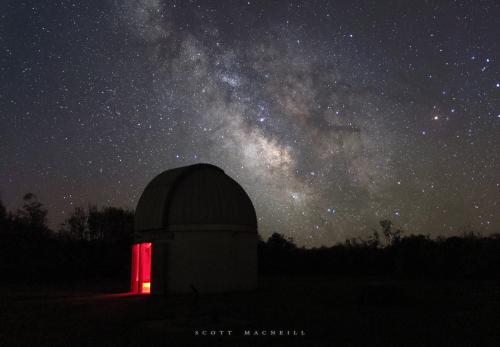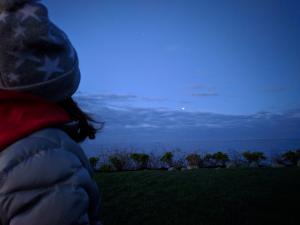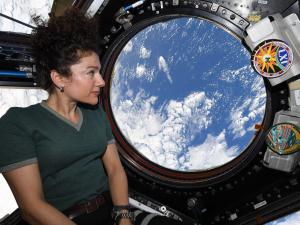Celebration of Space - July 14, 2023

The Milky Way over Frosty Drew Observatory on the night of the New Moon in 2012. Credit: Frosty Drew Astronomy Team member, Scott MacNeill.
On Monday, July 17, 2023 at 2:33 pm ET, the Moon will orbit into a position where it arrives between the Earth and the Sun, this is called conjunction, or better yet, the new Moon. On Monday, the new Moon will rise and set with the Sun, giving residents of Earth a full night of darkness. If you’re in the city, you will probably not notice the difference since light pollution will fill in the gaps. But if you reside in a location that is free of light pollution, thousands of stars will light up the night sky.
Considering that we are fast approaching two fantastic solar eclipses, the first on October 14, 2023, and the second on April 8, 2024, the new Moon is becoming a rather popular discussion point. This is because the only time a solar eclipse can happen, on Earth, is during a new Moon. Now the new Moon occurs every 29.5 days, which is the lunar synodic period, this will result in 12-13 new lunar phases per year. During these occurrences, the Moon is usually slightly below or above the Sun due to the orbital inclination of the Moon (5.1º to the ecliptic, or path the Sun takes across the sky). About twice per year the Moon will enter the new phase much closer to the ecliptic, this is when solar eclipses happen. But since the Moon is much smaller than Earth, an observer’s latitude matters, as well as what regions will actually experience the moment of conjunction, which is when the Moon actually passes between Earth and the Sun. In October and April, we are in the right places to catch a view. So step outside this Monday, if it’s clear out (wouldn’t that be nice), and enjoy the darkness.
This coming Wednesday, July 19, is a very important day for the Frosty Drew organization. It comes down to our namesake: Frosty Drew. It is the reason we do what we do, and the reason that the Ninigret National Wildlife Refuge and Ninigret Park exist. For those of you who do not know the story, here is a quick catch up.
Edwin Foster Drew, who’s nickname was Frosty, was a very unique person, who was passionate about ecology, parkland, fair use, and happiness. In his youth, Frosty was one of the children that contracted Polio before they were scheduled to be vaccinated. Frosty’s experience with Polio left his body disabled, but his determination, attitude, and significant intellect remained unaffected. He continued to excel, eventually graduating from Moses Brown, and Brown University. Though it wasn’t until his early 20’s that he would become known.
In the 1970’s the Charlestown Naval Auxiliary Landing Field (CNALF), which was heavily used during WWII, was decommissioned by the US Department of Defense. Changes in land use of Formerly Used Defense Sites (FUDS) occurred around that time, which allowed for the Yankee Electric Company to put forth a bid on CNALF with the plans to construct a nuclear power generation facility. Frosty Drew was very much against this proposition, and instead believed that CNALF should become a National Wildlife Refuge and public park land. He put together a petition, which turned into a coalition to fight the plant’s proposal. In the end Frosty Drew, and his coalition, defeated the Yankee Electric Company’s proposal, which resulted in the formation of the Ninigret National Wildlife Refuge and Ninigret Park on the CNALF land.
Frosty eventually became active in the Rhode Island Audubon Society and the Concerned Citizens of Rhode Island. He was the president of the Rhode Island Chapter of the American Littoral Society, and went on to become the chairman of the Rhode Island Commission on Energy. In September of 1976, Frosty Drew died from the physical complications that remained from his time with Polio. He was 28 years old. Frosty was inducted into the Rhode Island Heritage Hall of Fame in 1990 for his contributions to Rhode Island’s natural environmental heritage and the fame and distinction he brought to his state and nation. Wednesday would have been Frosty Drew’s 75th birthday.
Overnight tonight at 12:15 am ET (Saturday), the SpaceX Falcon 9 rocket will launch from Cape Canaveral, Florida carrying the next deployment of Starlink satellites to orbit. Depending on the direction of the launch, the launch vehicle may be visible from Southern New England. Weather tonight is not looking like it will work out for a view, though any of our East Coast readers, especially those near the shoreline, may have a chance to catch a view of this launch. If the launch proceeds as planned, you will want to be at a location with a good view of the SE → East sky, and be there for 12:10 am. Look for a fast moving, bright star-like object. We don’t know if it will be visible, but let us know if you see it!
Evening passes of the International Space Station (ISS), which kicked back in last week, continue through this week. Even though there aren’t many fabulous passes lined up for sky watchers this week, the ISS will still be visible passing over our region each night. Here are a few notable passes for this weekend and coming week:
Fri, Jul 14 at 8:59 pm, starting in the WSW, rising to 76º, heading towards the NE ← Awesome pass!
Sat, Jul 15 at 9:48 pm, starting in the NWN, rising to 24º, heading towards the NE
Sun, Jul 16 at 9:00 pm, starting in the W, rising to 32º, heading towards the NE
Mon, Jul 17 at 9:50 pm, starting in the NW, rising to 16º, heading towards the NNE
Tue, Jul 18 at 9:01 pm, starting in the WNW, rising to 19º, heading towards the NNE
Thu, Jul 20 at 9:02 pm, starting in the NW, rising to 15º, heading towards the NE
Even though most of these passes are not all that spectacular, they are still certainly worth a view. So grab your family, friends, or just your lovely self, and step outside this week for a view of the International Space Station passing over. For daily pass times of the ISS and other bright satellites, visit the Frosty Drew Daily Satellite Pass Prediction Utility every day. Now get out and see some space based residences!
- Author:
- Scott MacNeill
- Entry Date:
- Jul 14, 2023
- Published Under:
- Scott MacNeill's Columns




